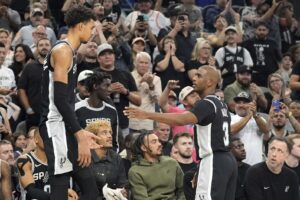For the Portland Trail Blazers, the latter half of 2016 was a time to forget. Blemished by various injuries, disappointing defense and failing to meet high expectations, the Blazers must look ahead to the new year with a sense of vigor and vengeance – should they expect their season to end up anywhere, that is.
While most of the spotlight from the media is shown on the swashbuckling backcourt of Damian Lillard and CJ McCollum, other players on the team have large weights to carry, including starting center Mason Plumlee. His role for the young team has been magnified tenfold after fellow center Festus Ezeli underwent knee surgery, one that will leave the defensive-minded big man out for the season. So how much value does Plumlee really add to this team, and how important will he be to the Blazers’ success looking forward?
On the Offensive Side
On the offensive side of the floor, there is no doubting Plumlee’s ability to not only operate down-low and in the paint but also act as the floor general at times making plays and key passes. He also displays a deceptive form of athleticism, catching lobs and throwing down reverse dunks in a guard-esque fashion.
Plumlee’s Player Efficiency Rating is good for being 19th amongst all big men in the league. Very respectable for a role player and ahead of the likes of Al Horford and Nikola Vucevic. While his points-per-game appears to be somewhat middling, he is the fourth scoring option of the current starters, behind Lillard, McCollum and Moe Harkless. In particular, however, what separates him from many other centers is his play-making ability – he averages the most assists per game of all big men in the NBA at 4.2.
While this is not the main job of a center, Plumlee’s passing ability offers HC Terry Stotts more facets from which he can run plays, keeping opposition teams guessing. At 6’11, he is also able to bring the ball up the floor to offence, without wasting time. This versatility ensures that opposing teams have to keep an eye on him as soon as he collects a defensive rebound, as he is not afraid to dribble the ball up the court.
Just before the year ended the Blazers played the Kings in a tightly fought contest, and with 3 minutes remaining in the fourth quarter the score was locked at 111 apiece. The much smaller and more agile Moe Harkless intercepted a pass and took it right away on the fast break. Plumlee, 26 pounds heavier and 3 inches taller, stayed right on pace with Moe. He received a pocket pass in the paint at full speed and while almost stumbling out of bounds, showed the composure to redistribute the ball with a return pocket pass to the now-open Moe, who finished with a simple layup. That play summed up the extra value of what Plumlee offers the Blazers on offence.
*Specifically found at 2:20.
https://www.youtube.com/watch?v=SANjQY8FyoQ
The Defensive Department
However, the fairytale ends on defence. Plumlee has shown progress but still has ways to go before he can be considered a very good starting center. In that very same game against the Kings, DeMarcus Cousins – Plumlee’s matchup – dropped 55 points on him.
In fact, of the big men in the league, Plumlee’s defensive field goal percentage is only good enough to place him 29th on that list amongst big men in the league. For Portland to become a serious name, they need their starting center to carry out his rim protection duties more effectively.
Part of the problem comes from size. At 6’11 and 236 pounds as mentioned earlier, he is not undersized as such, but the game today has evolved to teams generally having 7 foot or taller giants at the 5. The average weight of NBA starting centers is also 14 pounds heavier than Plumlee. While this gives him increased mobility and agility on offence, on defence this becomes a liability.
Time after time in the game against the Kings, Cousins simply backed down on Plumlee in the post. Whether or not Plumlee could potentially switch to the ‘4’ position is another topic for discussion. This would have him guarding slightly smaller figures.
Finally, yet another reason why it may be too hard for Plumlee to improve his defence on a large scale is the lack of mentorship available on the youthful team. The Portland big men rotation consists of the following players currently – these are the men who would be playing the 4 and/or 5 exclusively.
Meyers Leonard: 24 years, drafted ‘12
Ed Davis: 27 years, drafted ‘10
Noah Vonleh: 21 years, drafted ‘14
And Mason Plumlee: 24 years, drafted ‘13
No one stands out clearly with any veteran feel for the game and experience. This problem is maximised when Plumlee starts the game as a center with a matchup no one on the team has had much experience with. No one would be able to describe the little changes he would have to make to defend his man better. Things like that make all the difference in the game today.
Worth it?
Plumlee is still on his rookie contract, and thus his production compared to salary is maximised. He is almost certain to decline his qualifying offer for the next season as his wage can increase by a large margin. In fact, earlier this year the contract extension deadline passed without him resigning a new deal with the Blazers.
So while his future may be unclear with the Blazers, it’s important to use him as effectively as possible this season to hopefully climb back into the playoff picture. Ezeli’s injury has made Plumlee virtually untradeable, due to shortage of big men on the Blazers. They will have to do with his below-par defence but can continue to enjoy all his perks on the other end of the floor.
To conclude, Mason Plumlee’s value to the Portland Trail Blazers is undoubtedly prominent, but needs to pick up certain aspects of his game. Let’s see if he has it in him.
Main Image






